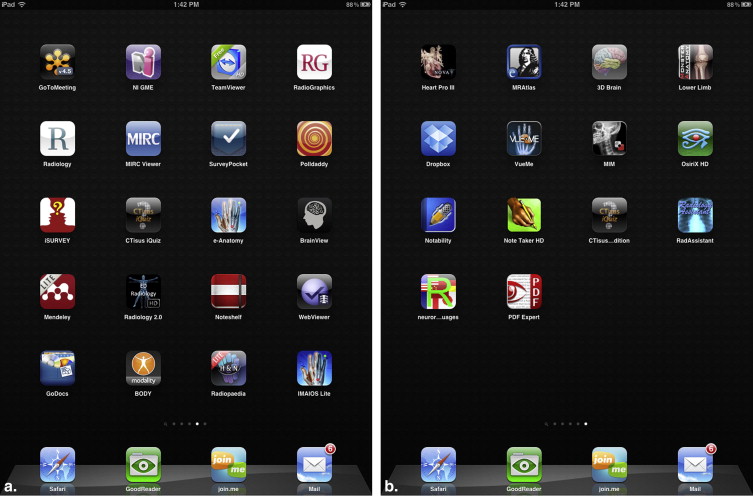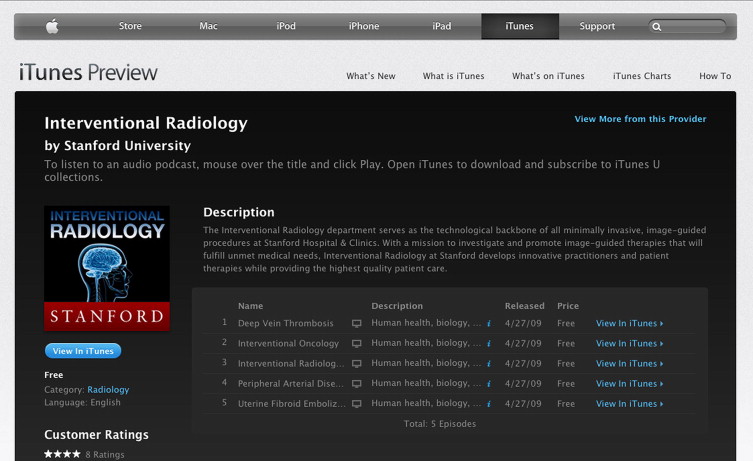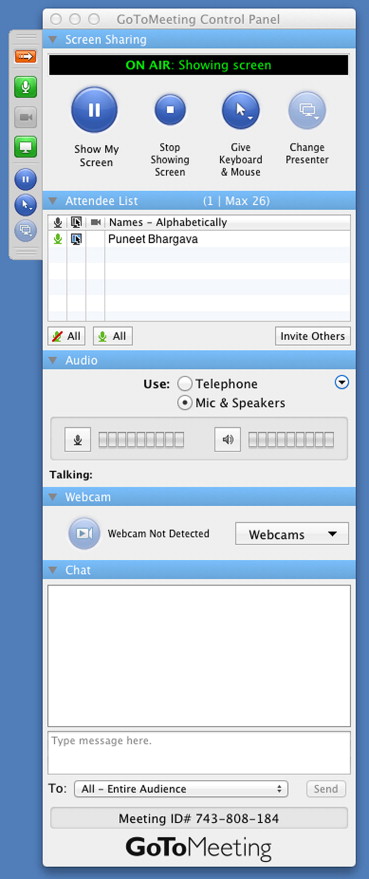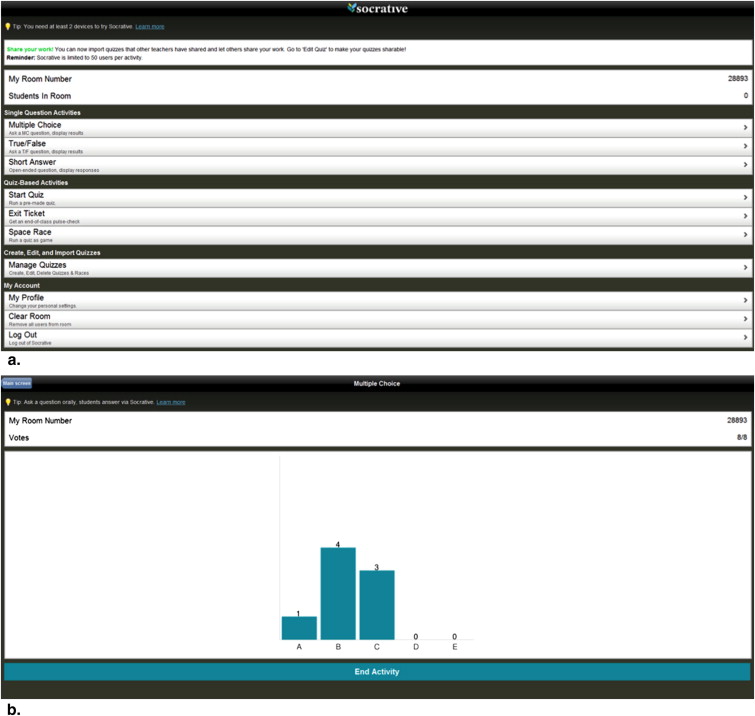We are in the midst of an evolving educational revolution. Use of digital devices such as smart phones and tablet computers is rapidly increasing among radiologists who now regularly use them for medical, technical, and administrative tasks. These electronic tools provide a wide array of new tools to the radiologists allowing for faster, more simplified, and widespread distribution of educational material. The utility, future potential, and limitations of some these powerful tools are discussed in this article.
Digital devices, such as smart phones and tablet computers, are increasingly being used within the medical world. Physicians are realizing that these devices can be used for a variety of medical, technical, and administrative tasks, as they are faster, more portable and generally more convenient than personal digital assistants and desktop and laptop computers. These devices offer the advantage of interactivity and connectivity. Most radiologists, like other physicians, own and regularly use these devices. In the past few years, the paradigm of radiology teaching as well as learning has shifted almost entirely from relying on textbooks to online learning using the internet.
There has been a clear shift in the ways that both residents and radiologists in practice prefer to gather information, with increased reliance on the internet as a first-line source. We are in the midst of a new educational revolution. Web browsing is giving way to a more interactive experience. Some of these powerful tools that are in the process of revolutionizing radiology education are reviewed in this article.
There’s an App for that! The tablet computing revolution
Utility
Tablet computing platform is here to stay and has revolutionized how we use and “feel” computers. Tablet personal computer sales are forecast to total 118.9 million units worldwide in 2012, a 98% increase from 2011 sales of 60 million units. Apple (Cupertino, CA) continues to dominate with its iPad and is projected to account for 61.4% of worldwide media tablet sales in 2012 . In addition to Apple’s premiere device, several other alternatives exist in the market today. Google’s popular operating system, Android, has been widely adopted by numerous manufacturers, including some of the more popular companies Samsung (Galaxy Tab; Seoul, South Korea) and Asus (Nexus 7; Taipei, Taiwan). Amazon’s Kindle Fire (Seattle, WA) and Microsoft’s Slate (Seattle, WA) are also among the other popular devices, and many other manufacturers already have a similar device on the market. Most of the non-Apple tablets come with several variations of technical specifications, ranging from screen size, resolution, expansion slots, front and/or rear facing cameras, and accessories. Newer tablets come with wireless and/or cellular technology capability, third- and fourth-generation of mobile telephony (3G/4G) for internet connectivity. Although wireless technology is not required for tablet function, the option allows for the ability to update software and browse the internet without being connected to a computer. The biggest distinction between all tablets relates to the underlying operating system and access to proprietary content: Apple’s App Store and Google’s Play . Both application stores offer nearly 700,000 applications for download, hundreds of which are medically related . Although some of the bigger developer’s create applications available to across platforms, the majority of applications are not universal and cannot be installed or viewed on different operating systems. This discrete incompatibility results in vastly different content depending on what device one uses on a daily basis.
Over the past decade, the way in which radiologists and radiology residents prefer to gather information has shifted to the internet . However, even though 97% of radiologists were found to use the internet for radiology education in one survey, those same radiologists cited the lack of portability as one of the most significant perceived drawbacks to web use . Enter the super-portable iPad! Weighing in at a maximum of 1.6 lb, internet educational resources are literally at our fingertips ( Fig 1 ). However, the iPad is not just for web browsing anymore, but rather is a powerful, versatile tool that is changing the face of education. Schools and universities across the world have embraced the iPad since its launch in 2010, with Yale, Brown, Stanford and University of California, Los Angeles (UCLA) among the growing list of medical schools implementing the iPad as the primary source of medical teaching . Incoming medical students are now being given iPads with their white coats! Residency programs have already begun to follow suit. The UCLA neurosurgery residency program recently sought to provide residents with time-efficient education by utilizing digital and mobile educational resources. In their study, all residents received electronic tablet devices with specific preloaded applications as well as the ability to remotely access relevant articles, textbooks, and collections of operative pictures and videos, which were stored on their network. Their standard curriculum was video recorded, stored in a digital library, and broadcasted through iTunes University (iTunes U) . Though time spent in the clinical setting, caring for patients, and honing skills is the richest learning experience of any training program, it is also important to capitalize on additional opportunities to gain knowledge in one’s field. They found that on the introduction of digital and mobile resources, 92% of the residents increased their time spent outside of the hospital studying, and there was a statistically significant performance improvement on their year-end competency exam . We predict that many more residency programs are soon to follow, and radiology, being more suited to web-based study than any other medical specialty, is likely to lead the way .
Get Radiology Tree app to read full this article<
Impression
Get Radiology Tree app to read full this article<
Get Radiology Tree app to read full this article<
Sharing online curriculums
Utility
Get Radiology Tree app to read full this article<
Get Radiology Tree app to read full this article<
Get Radiology Tree app to read full this article<
Get Radiology Tree app to read full this article<
Get Radiology Tree app to read full this article<
Impression
Get Radiology Tree app to read full this article<
Get Radiology Tree app to read full this article<
Remote meeting tools
Utility
Get Radiology Tree app to read full this article<
Get Radiology Tree app to read full this article<
Table 1
Summary of Popular Remote Meeting Tools and Comparative Evaluation of Their Features
GoToMeeting Infinite Conferencing Watchitoo Elluminate Yuuguu WizIQ Software None, Mac, and Windows. Web-based; no software downloads needed. Web-based, no software download required. Requires software download. Supports Windows, Mac, or Linux. No software downloads for participants. Will run on any internet server or smart phone. No software installation is needed. Runs on Windows and Mac. Needs Adobe Flash. Invitation tools Automated e-mail templates, webinar registration pages. Customized evite and registration. Automated e-mail confirmation and reminder. Integrated with Microsoft Outlook. Multiple embed locations, internal e-mail invitations. Various Instant Meetings or Automatic E-mail Templates. Its personal networking tool lets you see when colleagues or friends are online. Needs registration to join session. But educators can allow access to their content without signup. Can import e-mail contacts and send bulk invites. Can schedule meeting using the calendar tool. Collaboration tools Screen sharing via desktop and applications. Multiple presenters, annotating tools, text chat, teleconferencing, and VoIP. Has added mobile access and videoconferencing. Web conferencing, teleseminars, webcasting via webcams, webinars, phone conferencing, VoIP. Not currently compatible with mobile devices. Screen sharing, up to 25 presenters while simultaneously playing any form of rich media, text chat, questions, Twitter and Facebook posting, mobile access, videoconferencing, video editing, whiteboard and website integration. Share applications, files, documents, and desktops. Multiple video feeds, up to six. Annotating tools, text chat, teleconferencing, VoIP, videoconferencing. Virtual breakout rooms are available for larger audiences/conferences. Screen sharing via desktop, applications. Multiple presenters, annotating tools, text chat, teleconferencing, VoIP, mobile access. No videoconferencing. Screen sharing, supports multiple whiteboard, chat, multiple “classes” that can be created/joined, VOIP, webcam. Can also share files—documents, video, audio, even embedded YouTube videos. Recording Yes Yes Yes Yes, in Elluminate vOffice and vClass. Yes Yes, record sessions to share or view later. Polling and survey Yes Yes. Can create a customized survey and sent out via a url for $100. Yes Yes Yes Yes Post-meeting reports Length of stay in meeting and interest metrics. Yes Yes Yes, can generate comprehensive reports. Customizable. Yes, with detailed attendance reports. Pricing_GoToMeeting_ for meetings of 15 people or less for $49/month. GoToWebinar for $99/month (up to 100 people) to $499/month (1,000 people). GoToTraining , $149 to $349/month. Two pricing options. Billed on usage (how many people attend, for how long they are connected); unlimited usage package. Web conferencing: 6 cents/minute/connection. Free up to 5 people; up to 25 people for $39/month plan; up to 50 people for $49/month plan with a larger storage capacity. $499/year for licensing one room with up to 50 users, with pricing option for smaller rooms. Free for up to 5 participants. Single user $15/month, unlimited use with 30 participants, packages for larger groups. Free membership as well as Paid plans for Individuals, organizations or facility to Integrate virtual classroom in own website; Educators can create paid courses. Pay per use No Yes (see above) Yes for live events. Only for audio, not videoconferencing. No but $5 day pass No Trial 30 days 7 days 30 days 30 days Entry level is free—up to 5 participants. Reverts to free account after 30 days of trial.
Get Radiology Tree app to read full this article<
Get Radiology Tree app to read full this article<
Get Radiology Tree app to read full this article<
Get Radiology Tree app to read full this article<
Impression
Get Radiology Tree app to read full this article<
Get Radiology Tree app to read full this article<
Audience response system
Utility
Get Radiology Tree app to read full this article<
Get Radiology Tree app to read full this article<
Table 2
Steps to Implement Socrative Audience Response System
Steps Teacher Student 1 Register and log on for free, from any web-enabled device at www.t.socrative.com Using any web-enabled device (smart phone, tablet), go to www.m.socrative.com 2 Note the room number at the top of the page, and share with students Enter the corresponding room number 3 At any time during the presentation, pause to ask a question. This can be in the form of multiple choice, true/false, or short answer When prompted, respond using device 4 Results are instantly displayed on the presentation screen for both the presenter and the students
Get Radiology Tree app to read full this article<
Impression
Get Radiology Tree app to read full this article<
Get Radiology Tree app to read full this article<
Conclusion
Get Radiology Tree app to read full this article<
Acknowledgments
Get Radiology Tree app to read full this article<
References
1. Gartner says worldwide media tablet sales to reach 119 million units in 2012. Available at: http://www.gartner.com/it/page.jsp?id=1980115 . Accessed April 10, 2012.
2. App Store. Apple, Cupertino, CA. Available at: http://itunes.apple.com/genre/mobile-software-applications/id36?mt=8 . Accessed October 5, 2012.
3. Google Play. Google, Mountain View, CA. Available at: http://play.google.com/store . Accessed October 5, 2012.
4. Cook T. Apple iPhone 5 Keynote. San Francisco, CA. Available at: http://www.apple.com/apple-events/september-2012/ . Accessed October 1, 2012.
5. Lowe S. Google Play celebrates 25 billion downloads with 25 cent apps, discounted books, and movies. The Verge. Available at: http://www.theverge.com/2012/9/26/3409446/google-play-25-billion-downloads-sale . Accessed October 2, 2012.
6. Rowell M.R., Johnson P.T., Fishman E.K.: Radiology education in 2005: World Wide Web practice patterns, perceptions, and preferences of radiologists. Radiographics 2007; 27: pp. 563-571.
7. Kitchin D.R., Applegate K.E.: Learning radiology: a survey investigating radiology resident use of textbooks, journals, and the internet. Acad Radiol 2007; 14: pp. 1113-1120.
8. Scarsbrook A.F., Graham R.N.J., Perris R.W.: Radiology education: a glimpse into the future. Clin Radiol 2006; 61: pp. 640-648.
9. Bandukwala T., Arora S., Athreya S.: Net assets: review of online radiology resources, part I, educational resources. Radiology 2011; 261: pp. 350-356.
10. Flanders A.E.: What is the future of electronic learning in radiology?. Radiographics 2007; 27: pp. 559-561.
11. How schools are putting the iPad to work. Enterprising educators have big plans for Apple’s new tablet. Available at: http://www.macworld.com/article/1153672/ipaded.html . Accessed April 11, 2012.
12. iTunes University. Apple, Cupertino, CA. Available at: http://www.apple.com/education/itunes-u/ . Accessed May 1, 2012.
13. Gonzalez N.R., Dusick J.R., Martin N.A.: Effects of mobile and digital support for a structured, competency-based curriculum in neurosurgery residency education. Neurosurgery 2012; 71: pp. 164-172.
14. Kalb B., Gay S.B.: Internet resources for education in radiology. Acad Radiol 2003; 10: pp. S81-S86.
15. Ridley EL. Radiology finds a lot to like with the new iPad. Available at: http://www.auntminnie.com/index.aspx?d=1&sec=sup_n&sub=adv&pag=dis&ItemID=98762 . Accessed October 6, 2012.
16. DICOM monitors for the independent practice or smaller clinic. Available at: http://www.dicomsolutions.com/ds-digital-radiology/view.html . Accessed October 6, 2012.
17. Android tablets. Available at: http://www.mobiletechreview.com/Android-Tablet-Reviews.htm . Accessed October 6, 2012.
18. A look at the new iTunes U. Available at: http://www.insidehighered.com/blogs/look-new-itunes-u . Accessed May 1, 2012.
19. Apple unveils all-new iTunes U App for iPad, iPhone & iPod touch. Available at: http://www.apple.com/pr/library/2012/01/19Apple-Unveils-All-New-iTunes-U-App-for-iPad-iPhone-iPod-touch.html . Accessed May 1, 2012.
20. Salama M.: Radiology iTunes U. Emory Radiol Report 2010;
21. UCLA Radiology. Available at: http://itunes.apple.com/us/itunes-u/ucla-radiology-ucla-radiology/id434135593 . Accessed May 1, 2012.
22. Tutton M. Welcome to the University of iTunes. Available at: http://www.cnn.com/2009/BUSINESS/10/16/online.university/ . Accessed May 1, 2012.
23. ABR Exams of the Future. Available at: http://www.theabr.org/ic-dr-landing . Accessed May 1, 2012.
24. Krause M., Brado M., Schosser R., et. al.: Diagnostic accuracy in remote expert consultation using standard video-conference technology. Eur Radiol 1996; 6: pp. 932-938.
25. Carriero A., Beomonte Zobel B., Bonomo L., et. al.: E-learning in radiology: Italian multicentre experience. Radiol Med 2011; 116: pp. 989-999.
26. Kircher M.F., Hines-Peralta A., Boiselle P.M., et. al.: Implementation of screen-capture video recordings of resident conferences in an academic radiology department: pilot experience. Acad Radiol 2010; 17: pp. 255-263.
27. GoToMeeting. Available at: http://www.gotomeeting.com/fec/online_meeting . Accessed May 7, 2012.
28. Infinite Conferencing. Available at: http://www.infiniteconferencing.com/index.php . Accessed May 7, 2012.
29. Watchitoo. Available at: http://watchitoo.com/what_is_watchitoo . Accessed May 7, 2012.
30. WizIQ. Available at: http://www.wiziq.com/ . Accessed May 7, 2012.
31. YuuGuu. Available at: http://www.yuuguu.com/info/what-is-yuuguu . Accessed May 7, 2012.
32. Skype. Available at: http://www.skype.com/intl/en-us/home . Accessed September 30, 2012.
33. iChat. Available at: http://www.apple.com/support/ichat . Accessed September 30, 2012.
34. Elluminate. Available at: http://www.elluminate.com/Services/Training/Elluminate_Live!/?id=418 . Accessed September 30, 2012.
35. VoiceThread. Available at: https://voicethread.com/ . Accessed May 7, 2012.
36. Dropbox. Available at www.dropbox.com . Accessed May 7, 2012.
37. Kaleta R., Joosten T.: Student response systems: a University of Wisconsin system study of “clickers”. Educ Center Appl Res Bull 2007; 10: pp. 4-6.
38. Nicholson B.T., Bassignani M.J.: Radiologist/educator knowledge of the audience response system and limitations to its use. Acad Radiol 2009; 16: pp. 1555-1560.
39. Schackow T.E., Chavez M., Loya L., et. al.: Audience response system: effect on learning in family medicine residents. Fam Med 2004; 36: pp. 496-504.
40. Rubio E.L., Bassignani M.F., White M.A., et. al.: Effect of an audience response system on resident learning and retention of lecture material. AJR Am J Roentgenol 2008; 190: pp. W319-W322.
41. Pradhan A., Sparano D., Ananth C.: The influence of an audience response system on knowledge retention: An application to resident education. Am J Obstet Gynecol 2005; 193: pp. 1827-1830.
42. eClicker Presenter. Available at: http://www.eclicker.com . Accessed October 6, 2012.
43. iResponse App. Available at: http://iresponseapp.com . Accessed October 6, 2012.
44. What is Poll Everywhere? Available at http://www.polleverywhere.com/ . Accessed April 24, 2012.
45. Socrative: how it works? Available at http://socrative.com/ . Accessed April 24, 2012.



